By: debbie lynn elias
To paraphrase screenwriter Steven Knight, “Food is memories”. Since the days of a feeble Oliver Twist innocently saying “Please sir, I want some more” to Scarlet O’Hara infamously avowing “I’ll never go hungry again” to Charlie Bucket and Willy Wonka to Ratatouille to the Food Network and all its esculent edibles of every type imaginable, we have had a love affair with food. Within just the past year, food and the culinary arts have become front and center on the big screen with films like Jon Favreau’s “Chef” or “Haute Cuisine” and “Le Chef”. Is it world turmoil and economic upsets and the need for hearth and home and warm memories of the family gathered around the kitchen table at night sharing a meal that drives us to crave comestible comfort, even if vicariously on screen? Who knows. But whatever the reason, food and family are touchstones for us all. When director Lasse Hallstrom last seduced both the foodie and romantic within us, it was with the sensory intoxications of “Chocolat”. Now, with THE HUNDRED-FOOT JOURNEY, he delivers a rich savory blend of cinematic sugar and spice guaranteed to satisfy the hungriest cinephile! With a pinch of humor and a dash of romance blended to perfection, Hallstrom uses a light touch when whisking his cinematic ingredients together for one of the most delectable delights of the year.
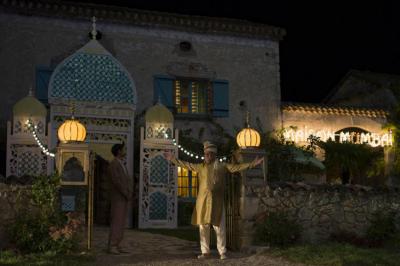
Victims of racist violence that destroys their livelihood and their life in their home of Mumbai, the Kadam family up and moves for a more idyllic and pastoral life in the south of France. Intent on resurrecting their business and bringing Indian cuisine to this uncharted territory of Michelin stars and haute cuisine, Papa and his brood, led by the culinary talents of eldest son Hassan, find an old stone manse that will serve their purposes nicely for the familial ambience they seek. With scent of aromatic filling and Indian music infusing the casual open air design of the new Maison Mumbai, what can possibly go wrong, what’s not love. Madame Mallory, that’s what.
Holder of a Michelin star, and desperate to earn its second, Le Saule Pleureur is the life’s blood of the OCDC perfectionist Madame Mallory who has maintained the traditions of elegance and fine dining started by her now deceased husband. Unfortunately, Le Saule Pleureur is located just 100-feet across the gravel covered street from Maison Mumbai, something to which Madame and her staff do not take kindly; after all, what kind of restaurant has chickens and children wandering free. Maison Mumbai must go.
It doesn’t take long before the battle of the kitchen wars takes hold with Madame Mallory and Papa butting heads at every turn, often to comedic result. But while the two of them duke it out everywhere from sidewalk cafes to the local farmers’ market to city hall, Hassan and Madame’s sous-chef Marguerite are exploring the culinary wonders of the region and their two cultures, with Marguerite tacitly instructing Hassan in the art of French cooking. While the sexual and professional tension between the two simmers to a low boil, it’s obvious that the real fire is between Madame and Papa.
But what happens when the flames of competition erupt into flames of hatred with the Kadams once again on the receiving end of violence and Hassan’s dreams of becoming a world class chef seemingly dashed.
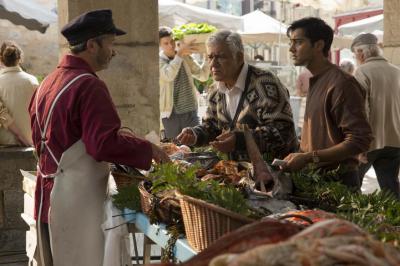
As Madame Mallory, Helen Mirren is as regal as ever. Describing the film as a “a joy to do. . . [b]e in that part of France, making a movie about food.. . .with three such delightful co-stars as I had – Charlotte [Le Bon] and Manish [Dayal] and Om [Puri]”, it’s Mirren and the equally legendary and talented Puri who do the heavy emotional lifting. Admitting that being able to employ a French accent and speak French which is self-admittedly “quite good”, Mirren is both luminous and chameleonic as the hauteur Madame. Of the philosophy that costume is as important a foundation to a character as foundational garments, Mirren was “quite proactive” in the look of Madame Mallory. “It’s of paramount importance, really, how you look and what you wear; that it tells the right story. . . That said, we had a brilliant costume designer who is actually a wonderful French guy, Pierre-Yves Gayraud.” Transforming Mirren into what she describes as a “chic French woman”, notable is the incremental change to hair, make-up and wardrobe mirroring the emotional growth of the story as Madame goes from rigid and stoic to a welcoming softness. Hair is looser, bouncy, and not as severe, eye shadow is added to make up, clothes go from rigid dark-colored suits to print silk dresses with scarves and Indian-infused pashimas metaphorically acting as an onion with layers being peeled away. As Hallstrom notes, “Costume design was actually very clever and subtle.”
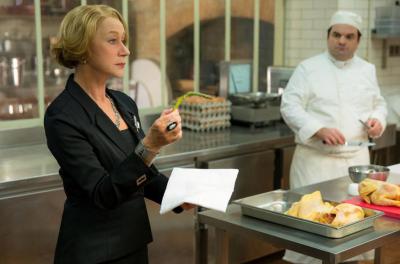
Furthering Mirren’s performance is her own pre-production preparation into the persona and ambience of a fine restaurant. Amazed “to see the extent to which chefs and restaurant owners are absolutely obsessed with food. . .but in this wonderful generous way; they’re not obsessed with food for themselves. They’re obsessed with giving someone the most incredible experience”, Mirren spent a day in a local Beverly Hills restaurant observing. Arriving at 9 am “when really the action in the kitchen of a restaurant starts happening”, Mirren became a fly on the wall. “I just stood quiet in the corner and watched everything going on. That was absolutely fascinating! Extraordinary. Sort of like a wonderful ballet of people moving around each other, small space, everyone knowing exactly where everything is, where they should be at any one time. The beauty of the workings, like a beautifully oiled machine. Quiet. Absolutely silent. Maybe a little bit of talking, but not raucous, no one shouting. . .Fascinating!”
Joining Mirren as the elder statesman in THE HUNDRED-FOOT JOURNEY is Om Puri. Matching Mirren skewer for skewer, creme puff for creme puff, the two sizzle and sparkle like a perfectly grilled steak and finest glass of champagne. Crediting Puri as turning the cast and crew into “one big family”, according to Mirren, who Puri is in real life isn’t too different than Papa. “He loves to make feasts. He’s a big family man and he just makes everyone around him into his family. He has that quality that he has on-screen, in real life, of just being this guy who loves life, loves, food loves women, loves family; that kind of a guy. So, he’s just a complete delight to be around.” For producer Juliet Blake, Puri was her first choice for Papa. “I wanted to go for somebody who had the best acting chops rather than somebody who had a particular look. . .Om is somebody who has worked in Pakistan as an actor as well as in India. For me, it was sort of the cross-culturalness of that that made [Mirren and Puri] interesting to play opposite each other.” The result is a performance that is both commanding and tender.
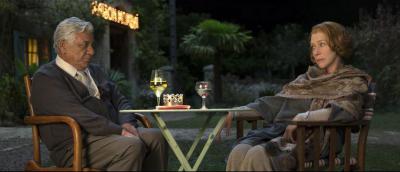
As Hassan and Marguerite, Manish Dayal and Charlotte Le Bon bring a fresh youthful vibrancy to the menu, something for which Hallstrom is most appreciative. “[T]here’s a lot of wonderful life, if I may say myself, especially between the young kids Manish and Charlotte, who were also interested in trying to forget that there was a camera there and really be honest and listen to each other.” They succeed in their efforts and fill the performances with natural organic facial responsiveness and reflex. To prepare for their roles, each had to go through some intensive culinary training in order to not only capture that ballet precision Mirren noticed in her kitchen observations, but for preparation and handling of food. Style and technique were essential for each to capture the expertise necessary to imbue the film with authenticity. However, scripted authenticity only went so far with Dayal who dazzled with his own culinary skills in a key omelet making scene. Playing to Hallstrom’s belief in freedom to ad-lib and infuse personality into a role, according to producer Blake, the omelet that Hassan makes is actually “[Dayal’s] father’s recipe and he insisted on the buttermilk. That was the omelet. And when he was saying to Madame Mallory, ‘Put some more in’ and she gives that look like ‘I don’t know’ – that is exactly how his family make omelets.”
Written by Steven Knight (the genius behind this year’s sleeper hit “Locke”) and adapted from the novel of the same name by Richard C. Morais, THE HUNDRED-FOOT JOURNEY is more about capturing the flavor of the book and the cross-culture pollination of France and India than its specific details; and that’s more than okay as it allows director Lasse Hallstrom to bring a delicate airy lightness to the film. Capitalizing on stereotypical cliches about the two cultures – the snobbish rude French, the garish loud music loving colorful Indians, the love of food and cooking – the cliches are also treated with a light touch adding fuel for fun and funny and setting the stage for rich performances from the film’s cast. The conceptual ideals of “a journey” are elicited on so many levels – romance, self-discovery, professional growth, cultural growth. Life is a journey. It may as well be a tasty one.
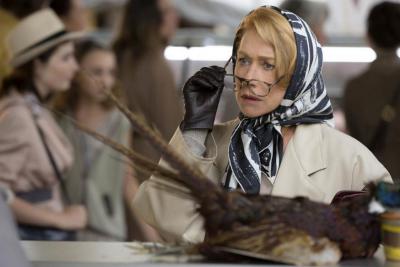
Subtextually, THE HUNDRED-FOOT JOURNEY is a blueprint for cultural co-existence, celebrating the underdog who gets by with a little help from his friends – and sometimes enemies – making food the true melting pot for the world. Inner conflict runs deepest within the character of Hassan and his journey. Unfortunately, that conflict never quite feels that conflicted or fully fleshed out; be it due to script or performance, I’m still not certain.
Known for his practice of letting the camera run and giving actors the opportunity to deliver variations of the scripted performance, not to mention his patented “One for Fun” final scene shots, Hallstrom recalled that “with Om’s presence there and Helen’s skill offering 10-15 varied options on each take, she’s so smart and inventive, all that created an atmosphere like a feeler for me of an Indian family.” The result gave Hallstrom and editor Andrew Mondshein “tons of footage” to cull through in cutting the final film, and I must say, there’s not a visual mis-step in the film.
Linus Sandgren’s cinematography is nothing short of delicate beauty, allowing the flavor of story and performance to bubble to the top of the production. Be they the panoramic vistas of the region, a saturated inky starlit night, the pale elegant classicism of Madame’s restaurant or the vibrant color filled richness of the local market, every image is just one more tasty morsel of enjoyment. The light in the film has a “light” touch to it; bright, yet soft, and just lacing the lightness of the film as a whole. Shooting on 35mm, widescreen lensing captures the bucolic pastoral beauty of the green trees and grassy land that surround both restaurants which, ironically are actually located 650 miles apart. A facade representing Le Saule Pleureur was erected across the drive from the Maison Mumbai for lensing the repeated 100-foot journeys between the two restaurants while exteriors of La Saule Pleureur such as the party scene were lensed at the second storybook country location. Aerial wide shots celebrate the metaphor of short distances bridging worlds and cultures.
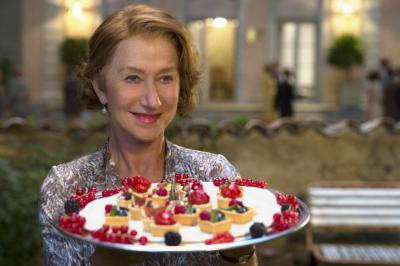
It was actually Sandgren who convinced Hallstrom to shoot THE HUNDRED-FOOT JOURNEY on film. Calling Sandgren “my favorite DP now”, Hallstrom feels the two “connected so well, almost a magical instinctual connection, the same way of thinking” leading to visuals and tone that have a lightness to them, with visual texture that is metaphoric for the emotional texture. As Hallstrom notes, “there is a much more subtlety in film. . .a film camera observes color much more in detail and much more subtle than a digi-camera can do.” Be it capturing the misty quality of the air at sunrise, the bucolic natural colors of the greens and the blues and that French sky or the sparkle of a fish splashing in the river, the result is luminous.
A production element present here not typically required on set are the culinary consultants – both for principal filming and for reshoots. As vegan Hallstrom laughs, “We had an Indian specialist and French specialist chef. And some of the food that was made, there was too much attention to taste than to the actual look!” which led to the talents of Floyd Cardoz who “was important because he was on the re-shoot when we did additional shooting. We had to re-shoot some of the closeups of the food.. .For us it was more important to look right rather than taste right!”
A surprising subtlety of the film is its score. I say surprising as the composer is A.R. Rahman who typically has a heavier hand than we hear with THE HUNDRED-FOOT JOURNEY. Composing a score with a great symphonic classicism that’s infused with the Bollywood sensibility for which he’s more well known, the result is beauteous. Working collaboratively, Hallstrom describes the scoring process. “We went through all the cues and said, ‘Now, here’s a French one, here’s an Indian one, here’s one where they collide, here’s one where they fuse, here’s a classical French symphonic version with an Indian flavor to it.’ We had all kinds of labels like that. I got to work with him in his studio while he recorded it. That was fun! I could be immediately be there to say this or that, more of that. He improvises a lot like I do. He does his music recording kind of similar to my way of working with film – last second impulses.”
No last second impulse needed here. Fulfilling, rich and delicious, THE HUNDRED-FOOT JOURNEY is an effervescent delight, sizzling with cinematic and emotional flavor.
Directed by Lasse Hallstrom
Written by Steven Knight based on the novel by Richard Morais
Cast: Helen Mirren, Om Puri, Manish Dayal, Charlotte Le Bon












